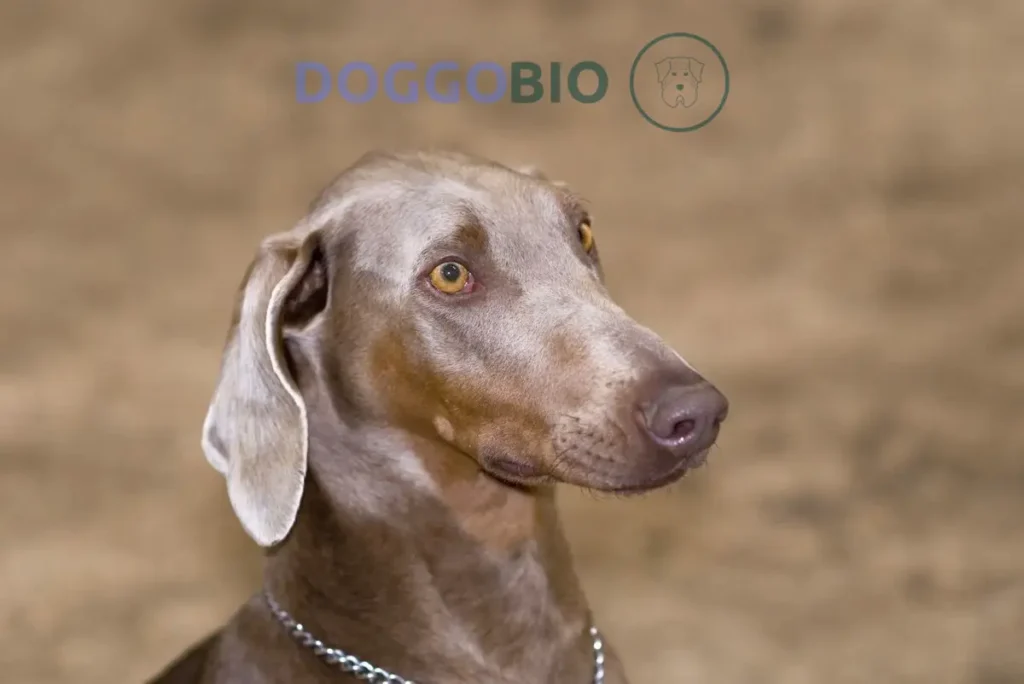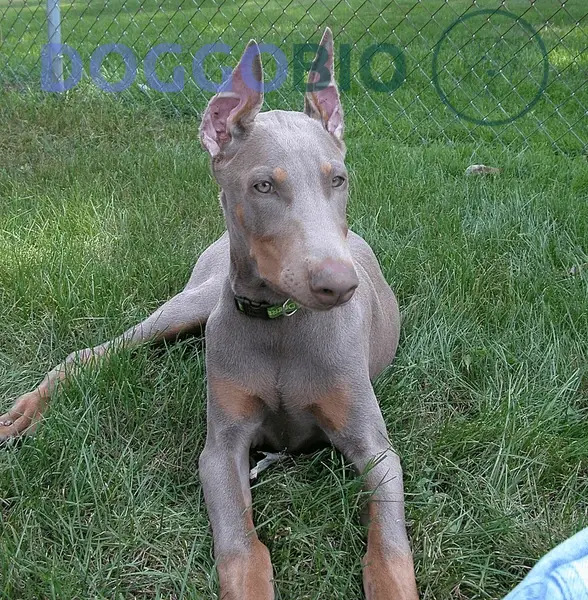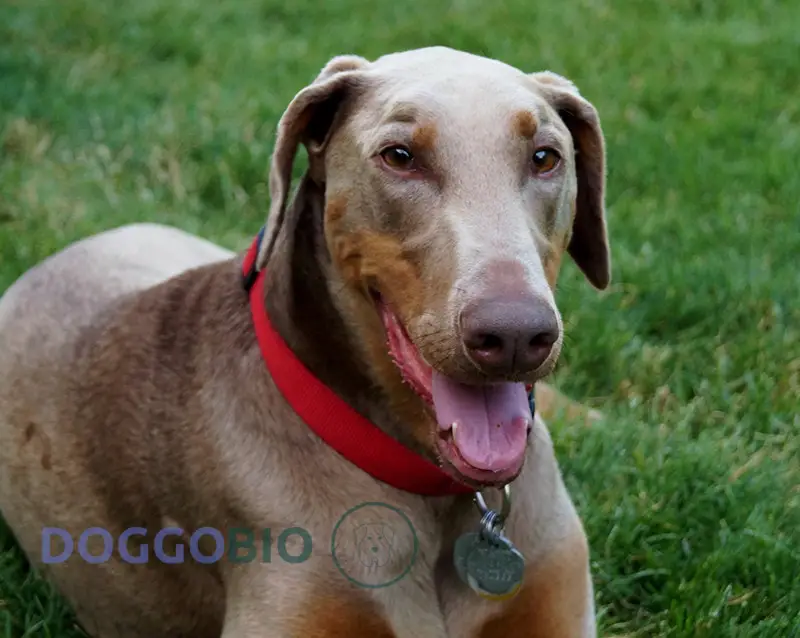Welcome to the fascinating world of the “Fawn Doberman,” a unique and captivating variation of the renowned Doberman Pinscher breed. With its striking appearance and distinctive characteristics, the Fawn Doberman has carved a niche for canine enthusiasts.
This exploration will delve into the origins, defining features, and personality traits that make this dog breed a remarkable and sought-after companion.
A Brief Overview of Fawn Doberman
| Feature | Description |
| Color | Light tan with black markings |
| Coat | Short, smooth, and sleek |
| Size | Male: 26-28 inches (66-71 cm) at the shoulder, 80-95 lbs (36-43 kg) |
| Temperament | Loyal, intelligent, energetic, brave, and confident. Needs socialization and training from an early age. |
| Lifespan | 10-12 years |
| Energy Level | High |
| Exercise Needs | Daily walks, playtime, and mental stimulation |
| Good with Children | Can be good with children with proper socialization and supervision. Not recommended for toddlers. |
| Good with Other Pets | May not be good with other dogs if not properly socialized. |
| Health Concerns | Hip dysplasia, cardiomyopathy, Wobblers syndrome, bloat |
| Grooming Needs | Minimal, occasional brushing |
What is a Fawn Doberman?

The Fawn Doberman, also known as the Doberman Fawn color, is a Doberman with a light brown or beige coat. This distinct color is due to a recessive gene, melanophilin, which dilutes the gene responsible for the red hue.
Apart from their color, Dobermans have two variants: American and European. Unlike its American counterpart, the European variant is taller and heavier, and the Fawn European Doberman is not considered a breed standard in Europe.
History of Doberman Pinscher
The Fawn Doberman Pinscher, or Isabella Doberman, results from genetic dilution. This breed has been around for many years and is recognized by major kennel clubs.
However, it’s essential to note that while the AKC accepts the Fawn American Doberman, the Fawn European Doberman is not considered a breed standard in Europe.
The history of the Fawn Doberman is intertwined with the history of the Doberman breed itself. Originating in Germany in the late 19th century, the Doberman was bred for protection and companionship. Over the years, various colors emerged, with the Fawn Doberman being one of the rarer variants.
Interesting Facts about Fawn Doberman
- The Fawn Doberman is different from the cream Doberman. While the Fawn Doberman still has pigmentation in its coat, the cream Doberman is considered a partial albino with minimal melanin pigmentation.
- The Fawn Doberman is one of the four standard colors of the breed, with the others being Black, Red, and Blue.
- The Fawn Doberman can sometimes be confused with the Weimaraner dog from Germany due to its color.
- Fawn Dobermans are prone to hair loss, with some showing signs of this condition as early as seven months old.
What does a fawn Doberman look like?
Size, height, and Weight
Fawn Dobermans are large dogs, with males weighing between 70 to 100 pounds and standing 25 to 28 inches tall. Females are slightly smaller, weighing between 74 to 75 pounds and standing 24 to 26 inches tall.
They reach their full height around one year, continue to fill out their chest and increase in Weight until they’re about two years old.

Coat colors and Types
The Fawn Doberman’s coat is light brown, a dilution of the red color passed genetically by a recessive gene.
They may exhibit rust or white markings above the eye, muzzle, throat, chest, or tail. Their coat are distinct and can sometimes be confused with other breeds like the Weimaraner.
Their short, sleek coat is easy to maintain, but potential owners should know the breed’s propensity for hair loss, especially in the Fawn variant.
Temperament and Personality
Despite their fierce appearance, Fawn Dobermans are affectionate and protective of their owners. They are sometimes clingy, often forming a solid bond with a particular family member. They are also strong-minded and dominant, leading to nipping or biting if not trained early.
However, with proper training and socialization, they make lovely family pets. Their loyalty is unmatched, and they often go to great lengths to protect their loved ones. This protective nature, combined with their intelligence, makes them excellent guard dogs. However, they also have a softer side, enjoying cuddles and playtime with their family.
Training and Exercise Requirements
Fawn Dobermans are intelligent and respond well to early training and socialization. They may show stubbornness if not trained consistently. Positive reinforcement is critical to ensuring they are well-behaved.
They are also highly energetic, requiring 1 to 2 hours of exercise daily, such as brisk walking or playing frisbee. Due to their high energy levels, they thrive in homes with spacious yards where they can run and play. Without proper exercise, they can become restless and may develop behavioral issues. Providing them with mental and physical stimulation is essential to keep them happy and healthy.
Grooming and Cleaning
Grooming this breed is relatively straightforward, but it needs nuances.
- Their unique coat requires regular brushing to keep it looking its best. While they are not heavy shedders, regular grooming can help reduce the amount of hair they shed.
- Bathing should be done as needed, but ensuring they are thoroughly dried afterward is essential to prevent skin issues.
- Regular ear cleaning, nail trimming, and dental care are crucial to keep them looking and feeling their best.
Food and Diet
The diet is a cornerstone of this breed overall health. Given their size and activity level, they require a nutrient-rich diet that can support their energy needs.
High-quality commercial dog food, supplemented with lean meats, vegetables, and occasional fruits, can offer them a balanced diet.
It’s essential to monitor their Weight and adjust their food intake to prevent obesity, which can lead to various health issues.
Life Expectancy and Common Health Issues
Like other Dobermans, the Fawn Doberman has an average life expectancy of 10 to 12 years. However, some can live longer with proper care, regular veterinary check-ups, and a balanced diet.
It’s essential to be aware of the breed-specific health issues and ensure they receive regular health screenings, especially as they age.
Regular exercise, mental stimulation, and a loving environment can also contribute to a longer, healthier life for your canine.

1. Wobbler Syndrome
Cervical Vertebral Instability: Commonly referred to as “Wobbler’s Syndrome,” this condition affects the cervical spine (neck) and can lead to a wobbly gait, neck pain, and potential paralysis. It’s caused by the narrowing of the spinal canal, which compresses the spinal cord.
2.Eosinophilic Panosteitis
Often referred to as “growing pains,” Eosinophilic Panosteitis is an inflammatory condition that affects the bones of young, growing dogs.
This condition can cause lameness and pain, especially in the legs. It’s more common in larger breeds like the Doberman. The exact cause is unknown, but it’s believed to be an autoimmune response.
The good news is that most dogs outgrow this condition by the age of two, though pain management and anti-inflammatory medications may be required during flare-ups.
3. Hypothyroidism
This is a condition where the thyroid gland doesn’t produce enough thyroid hormone. Symptoms include weight gain, lethargy, hair loss, and skin issues. Regular blood tests can diagnose this condition, managed with daily medication.
4. Albinism
While rare, there are albino Dobermans. They lack pigmentation in their skin, eyes, and coat. These dogs are more susceptible to sunburn and skin cancers and often have vision problems.
5. Bloat
Also known as Gastric Dilatation-Volvulus (GDV) is a life-threatening condition where the stomach fills with gas and twists on itself. It can lead to a rapid decline in health and requires immediate veterinary intervention. Symptoms include a swollen abdomen, retching without vomiting, and restlessness.
6. Skin Issues
Due to their unique coat color, Fawn Dobermans can be more susceptible to skin issues, including allergies, infections, and sunburn. Regular grooming and check-ups can help identify and treat these problems early.
7. Obesity
While not a disease per se, obesity can lead to other health issues, including joint problems, diabetes, and heart disease. A balanced diet and regular exercise are crucial to keep your Fawn Doberman in optimal shape.
8. Kidney Disease
Like many larger breeds, Dobermans can be prone to kidney diseases. Regular blood tests and vet check-ups can help in early detection and management.
9. Liver Disease
The liver is a vital organ, and dysfunction can lead to severe health issues. Symptoms can include jaundice, increased thirst, and changes in behavior or appetite.
10. Cataracts
Just like in humans, Dobermans can develop cataracts, which cloud the eye’s lens and can lead to blindness if untreated. Regular eye check-ups can help in early detection and treatment.
11. Progressive Retinal Atrophy (PRA):
This is a group of genetic diseases that cause the eye’s retina to degenerate slowly over time. The result is declining vision and eventual blindness. While there’s no cure, early detection can help manage the condition and make life easier for the affected dog.
12. Color Dilution Alopecia
This genetic condition is commonly seen in dogs with diluted coat colors, like the Fawn Doberman. It leads to hair loss and can cause the skin to become dry and flaky. While there’s no cure, regular vet check-ups and specific shampoos can help manage the condition.
How much is a fawn Doberman?
The average cost of a Fawn Doberman ranges from $1,500 to $2,000, depending on the breeder’s reputation and location. This price can be higher due to the rarity of the Fawn coloration.
When considering purchasing, it’s essential to factor in additional costs such as vet bills, food, training, and grooming.
How Can I Find a Fawn Doberman For Sale?
Finding a Fawn Doberman for sale requires research and patience. Given their rarity, finding reputable breeders who prioritize health and temperament over color is essential. Visiting breeders, attending dog shows, and joining Doberman-specific forums can aid in your search.
Is a fawn Doberman the Right Dog for You?

They require time, effort, and love. In return, they offer unwavering loyalty, protection, and companionship. If you’re prepared for the responsibilities, a Fawn Doberman can be an excellent addition to your life.
List of dogs that are similar to Fawn Doberman
- Doberman-Husky Mix
- Doberman-Chihuahua Mix
- Doberman-Pitbull Mix
- Doberman-Cane Corso Mix
- Doberman-Great Dane Mix
Frequently Asked Questions
Does AKC recognize Fawn Doberman?
Yes, the AKC recognizes the Fawn Doberman. However, potential owners should be aware that while the Fawn color is identified, it may not be preferred in show rings.
What is the rarest color for a Doberman?
The Fawn Doberman and the cream variant are among the rarest colors. Both these colors are due to genetic dilution and are not as common as the black or red variants.
Are fawn Dobermans Rare?
Yes, they are considered rare due to the recessive gene responsible for their color. This rarity often leads to higher prices and increased demand among enthusiasts.
Are Dobermans high maintenance?
Yes, Dobermans can be considered high maintenance in training and exercise.
While their grooming requirements are relatively low, they demand consistent training and ample exercise to stay mentally and physically fit.
Additionally, regular veterinary check-ups are essential due to their susceptibility to specific health concerns.
Are Fawn Dobermans prone to specific allergies?
Yes, Fawn Dobermans can be prone to specific allergies. Like other Doberman types, the Fawn variant might exhibit sensitivities to particular food items and environmental factors.
Routine veterinary visits and vigilant observation of unusual symptoms can aid in early detection and effective management of potential allergies.
What’s the best way to handle a Fawn Doberman’s high energy levels?
Regular exercise is critical. Activities like fetch, tug-of-war, agility courses, and long walks can help burn off their energy. Mental stimulation, like puzzle toys and obedience training, can also keep them engaged.
Can Fawn Dobermans be left alone for long periods?
No, Fawn Dobermans should not be left alone for long periods.
Like other Doberman variants, they are renowned for their deep attachment to their human family members. Prolonged solitude can induce separation anxiety in them, potentially resulting in undesirable behaviors like property destruction or incessant barking.
For individuals with regular work commitments that necessitate extended absences, it’s advisable to explore options like doggy daycare or engaging a dog walker to provide intermittent company and activity for the dog.
Is Fawn Doberman same as cream Doberman?
No, the Fawn Doberman has pigmentation, while the cream Doberman is partially albino. Both colors are due to genetic dilution, but they are distinct.
Do Dobermans Smell More Than Other Dogs?
No, they have a similar odor level to other breeds. Regular grooming can help reduce any potential odors.
How often should a Fawn Doberman be bathed?
Bathing once a month or when they get filthy is usually sufficient. Overbathing can strip their coat of essential oils, leading to dry skin.
Is crate training recommended for Fawn Dobermans?
Crate training can be beneficial, especially during the puppy stages. It can provide a safe space for your Doberman and aid in housebreaking. However, it’s essential not to leave them crated for extended periods.
Is a fawn Doberman Aggressive?
No, a Fawn Doberman is not inherently aggressive. However, they possess a protective nature and might display aggressive tendencies if they sense potential danger to their family or loved ones.
Proper training and socialization are essential to ensure they exhibit balanced behavior.
Are Fawn Dobermans good guard dogs?
Yes, Dobermans are known for their protective instincts, making them excellent guard dogs. Their imposing stature, combined with their alertness, can deter potential intruders.
How do Fawn Dobermans react to strangers?
They are naturally protective and can be wary of strangers. Early socialization and training can help them differentiate between friend and foe. Proper introductions can ensure positive interactions.
How do Dobermans interact with children and other pets?
When socialized early, Fawn Dobermans can be great with children and other pets. Their protective nature makes them vigilant guardians for kids. However, due to their size and energy, it’s essential to supervise interactions with younger children.
Aren’t all Dobermans a bit “clingy”?
Yes, they tend to form strong bonds with their owners. This clinginess can be endearing, but potential owners should be prepared for a dog that always wants to be by their side.
Is a fawn Doberman Easy To Train?
Yes, with consistent training. Their intelligence and eagerness to please make them highly trainable.
Are Fawn Dobermans good swimmers?
No, Fawn Dobermans are not natural swimmers. However, Fawn Dobermans can be taught to swim and may come to appreciate water-based activities, particularly in hotter environments.
It’s imperative to monitor them closely when they’re near water, and utilizing a dog-specific life jacket can offer an added layer of security.
Why is my fawn Doberman shaking?
It could be due to anxiety, a cold, or a health issue. If the shaking is persistent or accompanied by other symptoms, it’s essential to consult a veterinarian.
How Long Can a Fawn Doberman Live?
They have a life expectancy of 10 to 12 years. They can live a long and healthy life with proper care, regular check-ups, and a balanced diet.
Can Fawn Dobermans tolerate cold and hot weather?
No, Fawn Dobermans cannot fully tolerate extreme cold or hot weather. Given their short coat, Fawn Dobermans lack substantial protection against severe colds, making doggy sweaters or jackets advisable during colder seasons.
Conversely, in hot conditions, they are susceptible to overheating. Hence, ensuring access to shade and continuous fresh water supply is vital during warmer periods.
How much space does a Doberman need?
Given their size and energy levels, Fawn Dobermans thrive in homes with spacious yards. However, they can adapt to apartment living with adequate daily exercise.
Do Fawn Dobermans Shed A Lot?
No, Fawn Dobermans do not shed a lot. While they possess a short coat that sheds moderately, routine grooming can aid in minimizing shedding and maintaining healthy skin.
Are fawn Dobermans hypoallergenic?
No, they are not considered hypoallergenic. However, their short coat produces fewer allergens than longer-haired breeds.
What is another name for fawn Doberman?
They are also known as Isabella Dobermans. This name is derived from the unique color of their coat.
Conclusion
The Fawn Doberman is more than just a dog; it’s a statement. Their unique color, combined with their loyalty and intelligence, makes them a standout breed.
Whether you’re seeking a loyal companion, a diligent guard dog, or a show-stopping beauty, the Fawn Doberman fits the bill. They can be a cherished family member with proper care, training, and love.

Pingback: Doberman Husky Mix: Fascinating Facts You Need to Know 2024
Pingback: Doberman Pitbull Mix: The Amazing Features of the Dober Pit 2024